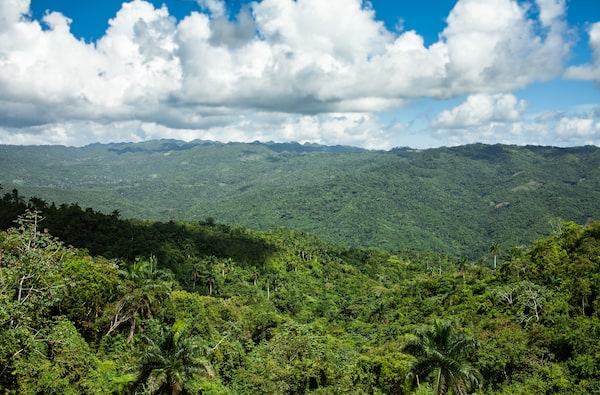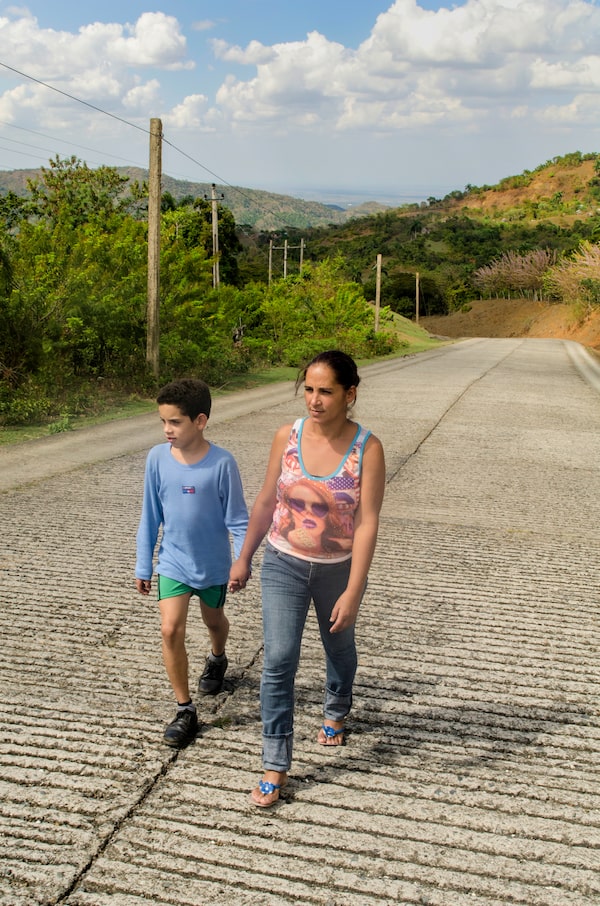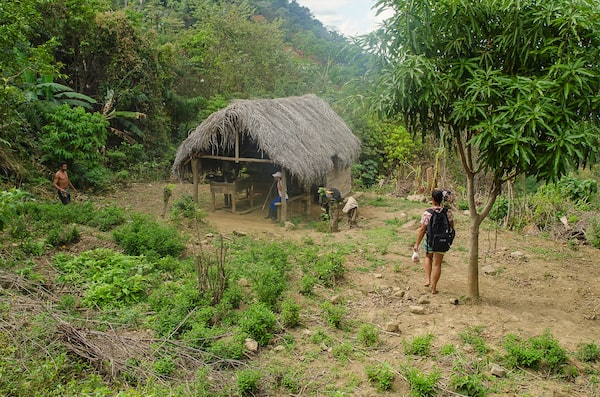
A view from the Sierra Maestra mountains in Cuba.Marc Borchert Kraueler Hauptdeich 37b 21037 Hamburg/iStockPhoto / Getty Images
Into the heart of southeastern Cuba, we drove our rental car through long farm roads flanked by a vast green sea of sugar cane. With my companion, Libby, our destination was the hamlet of Santo Domingo, gateway to Turquino National Park in the Sierra Maestra mountains. (Not to be confused the with the city of Santo Domingo in northern Cuba.) Yet, it is far more renowned as the home of Comandancia de la Plata, Fidel Castro’s hideaway and secret armed camp in the late 1950s, prior to his final assault on the Batista regime.
Industrious Cubans walked or cycled the roadside, enduring searing midday heat – some shouldering farm tools, others herding livestock or shepherding children. Our economy rental car, with faint AC, seemed luxurious by comparison.
Soon, the plains met the foothills, the farm road arched into lowland forest and the stifling air began to cool. From the last flatland town of Bartolome Maso, the road ascended steadily for 14 kilometres. In the village of Providencia, we passed a sign marking eight kms to Santo Domingo and warning of dangerous mountain curves ahead. The road to Santo Domingo is so steep, our guidebook warned that many Cuban vehicles can’t make it. Our little white rental was gasping, but finding traction on the ribbed pavement.
Suddenly, a woman and a preteen boy leapt onto the road, eager to get our attention – and a lift. I pulled over, offered a welcoming gesture and they jumped in. Rosita, and her son, Erisdiel, explained that they walk this mountain road every Friday afternoon to return to their home at the end of his school week. As we spoke, I needed to downshift into first gear to make it haltingly up and around curves. While our engine groaned, I tried to fathom our passengers’ weekly eight-kilometre uphill trek.

Rosita and Erisdiel walk the first leg of the daunting Friday afternoon route to their mountain home.Todd Shapera/The Globe and Mail
After navigating steeper switchbacks near the top, the road shot downhill like a roller coaster and banked hard left to cross a concrete bridge over the Yaro River. We entered the bucolic Santo Domingo valley, a settlement walled off on all sides by forested mountains. Rosita directed me to continue on the road, passing a few modest homes, past the big sign for the entrance to Turquino National Park. Then we coasted a hundred metres downhill to the bank of the Yaro River and literally, the end of the road.
“This is it,” Rosita announced. As we exited the car to say goodbye, she pointed high above the pine forests, gesturing to soaring distant mountains and exclaimed, “We live up there!”
We were speechless.
We only now understood that Rosita and Erisdiel didn’t live here in Santo Domingo after all – they still had a full afternoon’s trek home into the mountains.
The spectacular landscape enveloping us crushed Caribbean island stereotypes. Turquino National Park’s nearly 230 square kilometres of mountains includes Cuba’s highest point at 1,975 metres, Pico Torquino. It’s misleading to think these peaks are modest compared to the far higher Rockies or Alps, since they virtually rise from the sea.
“No one else lives there,” Rosita added, as we all gazed up. They were already turning away to set off. As they walked toward a shaky planked footbridge that stretched across the dry, pebbled riverbed, I blurted out: “We want to come see your home!”
Rosita stopped in her tracks and turned back to me. Her face lit up, embracing my impulsive gesture.
At her suggestion, we enjoyed a delicious lunch of trout, rice, beans and cold Cuban bear at a nearby restaurant as she and Erisdiel followed a narrow path toward the mountains. Then we scouted out our lodging options and paid $28 to spend the night at Heidi’s, one of three modest casa particulares (the Cuban version of a bed and breakfast) on the hamlet road.
If my desire to visit Rosita at first seemed whimsical and unattainable, our journey came together surprisingly easily. When we told Heidi the story about our new acquaintances, she immediately knew who they were. She booked a trusted guide to show us the way up the mountain for just $10 each.
The next morning, as we devoured an ample breakfast (an extra $8), Juan Luis – our leader for the day and Heidi’s neighbour – walked across the adjoining yard with a relaxed smile, carrying two walking sticks. He took us up the paved valley road past the Turquino Park entrance and over the Yaro River footbridge. Pigs and piglets, chickens and an occasional farmer leading a small train of supply mules shared the path with us.
I wondered whether, culturally, we were doing the right thing. Had we interpreted Rosita’s openness to our visiting her correctly or was she just being polite?
Soon, however, we were disabused of this concern by Rosita herself. About 40 minutes into our hike, we were surprised to find her sitting on a boulder along the river bank.
“I’ve been waiting for you,” she exclaimed. She had presumed we’d come, even though we had no idea where she lived, so had chosen to overnight with a family at the base of the mountains.
Even as the route was gruelling – three hours on a steep, slippery, gnarly goat path – our eden-like surroundings were a balm. The park is a sanctuary for numerous plants and animals endemic to the area. Lower-elevation tropical forests transitioned into moist forests and then higher-elevation pine woods. Midway, when Juan Luis stopped in the shade of some cacao trees for us to rest, he reached for a fruit and peeled one to show us the white glistening texture inside.
Eventually, past midday, Rosita pointed out a hut nestled beneath palm trees on a distant slope. It was the home of her sister, Nancy. If our visit was unplanned, it seemed we were somehow still expected. Nancy welcomed us with a bright smile and open arms. She invited us to step through an open doorway into her kitchen, sit on a wooden bench and rest our weary legs. A few feet away, she squatted on a stool, braced a large wood gourd between her knees, took up a pestle and began vigorously grinding coffee beans. While she worked, we observed her home and drew on my perfunctory Spanish to chat.
The sloping roof of the kitchen was thatch, the far wall was frayed tarp, the floor simple earth. Yet all was orderly as any functioning kitchen – wood-burning stove, black metal cooktop, a wooden dish rack built on a wall next to cubbies for staples and supplies. The rest of the structure was laid out railroad style, with a short hallway and three small bedrooms with a tin roof, wood slat walls and a polished concrete floor.
Soon, Nancy spooned the ground beans into a strainer over the wood stove and poured in boiling water. In our posthike exhaustion, the strong, Cuban coffee was welcome refuelling. Nancy surprised us further by serving an ample meal: black and red beans, malanga root, rice, lettuce and tomatoes. It was our most delicious meal in Cuba in one of the country’s most gorgeous settings – enjoyed at the top of the Sierra Maestra, surrounded by steep, forested slopes.
Our hosts lived alone on their Cuban mountain, with no other dwellings in sight. As travellers from another land, it felt idyllic, even though we knew full well their subsistence here was beyond difficult. I tried to learn more about their hardships and challenges, without seeming to pry. “Where did you deliver your babies?” I asked. “We walked down the mountain to the clinic,” Rosita answered, unfazed.

The footpath to Rosita's simple hut in the Sierra Maesta mountains. Her home's thatched roof covers an open-air kitchen in front and an enclosed bedroom in back.Todd Shapera/The Globe and Mail
If I felt envy for their lives, seeing it through my own exhilaration of being there. It was difficult to sustain the enthusiasm after walking a path across the mountain top to Rosita’s one-room cabin, nestled in a small clearing. The kitchen was open to the elements on three sides, covered by thatch, backed by a one-room wood structure that housed a cramped bedroom, with space only for a double mattress – the sleeping quarters for all three of them. That was it. No furniture, few possessions other than clothes, a few sturdy cooking pots and a tarp with home-grown beans drying in the sun.
With the afternoon moving on, we needed to plan our long descent in daylight, to arrive before the 6:30 p.m. or so February sundown. We shared warm, heartfelt embraces. I gave Rosita and Nancy a modest gift to express our gratitude and to cover their food costs, as well as a sweatshirt from my pack for Erisdiel.
If we imagined the downhill hike would be less gruelling than the ascent, we were soon disabused. The challenging descent meant repeated pounding on our knees and shins and ankles, and sliding on the narrow path. Back at our casa, we devoured a rice and bean dinner.
The next morning we recovered in the shade of a fig tree on Heidi’s lawn and made notes in our journals, reflecting on our amazing journey.
“See those mountains up there, that’s where we walked!” I remarked.
”It’s but a dream,” Libby replied.
Live your best. We have a daily Life & Arts newsletter, providing you with our latest stories on health, travel, food and culture. Sign up today.